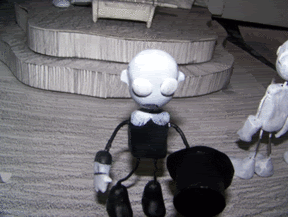I never had much of a fondness for images of poor quality, but I have dealt with them, and on occasion have learned to love them. For instance, I used to watch pirated movies online {that I own now so please don't come after me you have no proof that I might have broken the law because I didn't say which movies and I do in fact own movies. =P} and I actually fell in love with a few even if the quality of the image wasn't cinema pristine. It was instant gratification; I wanted to see So and Such and I got to see it by poking around the internet. But when it comes to references, or when I want to see something as I might be able to see it in person, poor images tend to get on my nerves. I understand what they can be good, or even great for. I won't switch to the higher-priced HD television just so I could see the freckles on the news anchor's face. I don't mind losing a little information. That doesn't always make an image poor anyways. I think 'poor' is pretty subjective. If you're talking about the picture of missiles in the article that looks like a jpeg saved ten times over, then yeah, maybe it is poor quality. But what about to someone who simply wants to know what a missile from that angle looks like? They'll deal. They'll trace around it and look for a better pictures to get the details from.
But does that make their image poor quality? Once again, it's subjective. It could still look realistic to one person or another.
On to the answers:
1. I believe the author meant to pick at images that have been uploaded, ripped, saved in other formats, or generally deteriorated from the original source. It doesn't even have to be something that has been circulating for a while. A picture of a bird perched on a tree taken by your Nextel camera phone can be just as poor a quality.
2. The contemporary heirarchy of images is in reference to quality over content. In this case, something with far more detail and clarity would be a higher-class image while something that exhibits signs of interference and lack of definition would be of a lower class.
3. I guess work is experimental if it's approached with an idea that is yet to be tested. I liken it to a science project after you've got a hypothesis to work with. You get whatever materials you think are going to be necessary and you try out an approach you've never taken before.
4. I don't think so. I only think of an image as poor when it's failing to meet the right expectations. If I want something with detail, then anything with a lack of clarity will seem poor to me. If I just want to watch an edited video of He-Man singing 'What's Going On' in a flamboyantly camp design in his mid-80's television series for the amusement, the re-hashed edit of a complete show with a lack of detail doesn't butt into it. I'm still laughing, everyone's synced to the music, and I could care less what quality the article's author might assign to it. It's great shit.
5. The quality of a painting is traditionally judged on different terms, however, with the introduction of projectors, slides, then computers and file-sharing {etc}, something changed. Looking at a painting without seeing the physical painting is a drastically different experience. It's like how you've seen the Mona Lisa pictured in textbooks or projected against a wall about 6"x3" or something and then you go and see it at the museum and realize...it's a lot smaller. It's a lot darker/lighter. It's a lot more weathered/manicured in appearance. Seeing the image of a painting VS being in the presence of the real deal are two different experiences.
6. Like I said before, I believe the quality of the image is ultimately determined by the individual. A 'poor' quality image to one might be just what another is looking for. In general, or in terms of digital media, it's only absolute in definition. A highly compressed jpeg that looks like a manic oil painting with random pixels breaking it up will be considered poor simply because of the file-type. But I simply measure the quality based on its use to me.
7. I like to look at reference material for a lot of my work, but the quality is only an issue if I want details that most lower quality images can't provide. And with the stop motions I've been making lately, I try to make the motions seem more professional with every trial. But I've come to love my choppier style.
8. The human condition cuts into it a lot. Since my work is heavy on the insight, if I'm feeling any which way, my work often follows. I don't have a lot of personal qualms except for a fear of the future, and that's pretty much what my apocalyptic subject was born from. My desire to have the present cease so the future might never come to exist.
My stop-motion, when I think about all the ones I've seen, might seem low in quality by more traditional terms. It isn't fluid, the movements are awkward, and the effects are easier to decipher. When I compress the video files, I obviously don't click on the most definite save. I have a preference, and so far the digital quality of it hasn't let me down in the past. It may not be HD, but I don't need the details to be /that/ apparent. I like to leave a lot to the imagination, and I'm sure that's another charm poor quality images might have to offer.

No comments:
Post a Comment